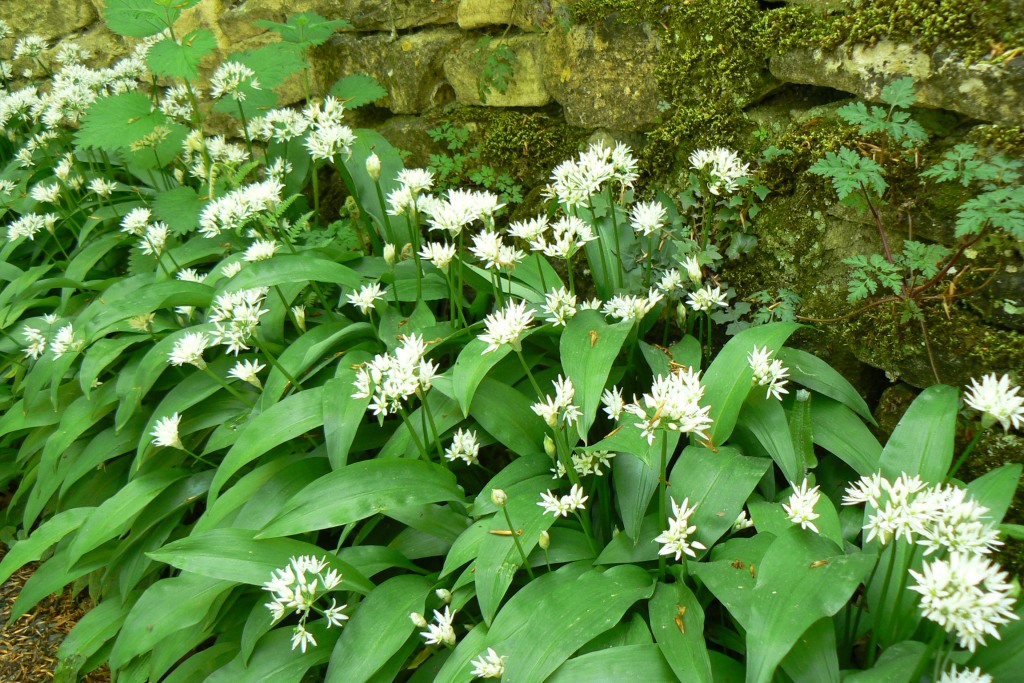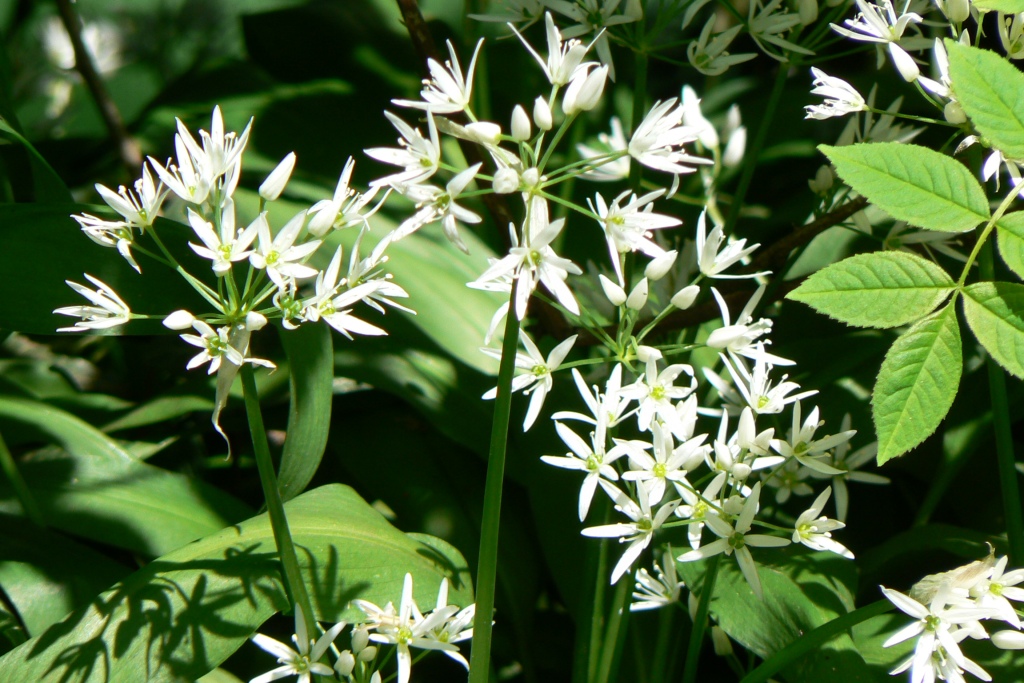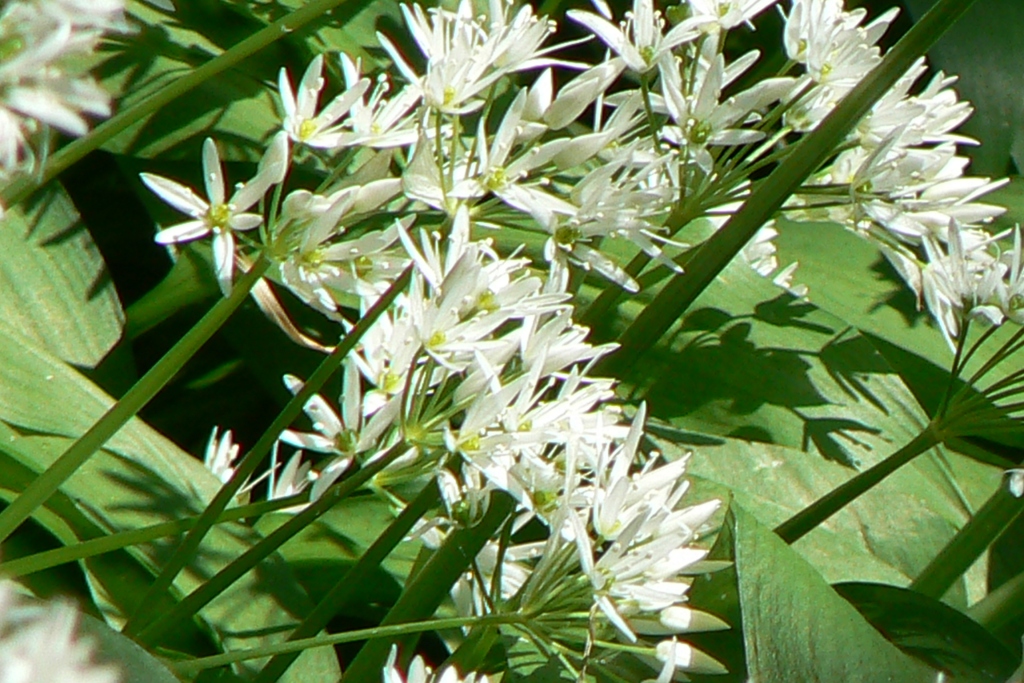
[016] Allium ursinum, Wild Garlic
Introduction
Allium ursinum, Wild Garlic, is an insignificant small plant found in woodland but in early Spring it provides areas of white flowers comparable to similar spreads of [154] Snowdrops or [178] Bluebells. If you pick a leaf and rub it you can smell the familiar scent of garlic.
Wikipedia suggests that it is also known as wood garlic, bear leek, bear’s garlic, broad-leaved garlic, buckrams or ramsons, but to me it is always wild garlic.
Taxonomy
Kingdom – Plants
Clade – Angiosperms (Flowering Plants)
Clade – Monocots (See below)
Order – Asparagales
Family – Amaryllidaceae
Genus – Allium
Scientific Name – Allium ursinum
Wikipedia lists about 15 synonyms, most of which are Allium. It also suggests that the genus Allium is hard to determine and may contain between 260 and 979 species!
Name
Wild Garlic is a classic example of the difficulties of using common names. In Britain Allium ursinum is known as wild garlic. It’s common, widespread and well-known.
But if you ask Wikipedia it gives eight other choices of Allium species from around the World that not unsurprisingly are known somewhere as wild garlic. It also notes that in Africa there are species of Tulbaghia called wild garlic. This is a closely related genus and they have the same familiar scent.
It is, of course, called wild garlic because it is a close relative of Garlic (Allium sativum) and similar species the Onion (Alium cepa), Leek (Allium ampeloprasum) and Chives (Allium schoenoprasum).
The word ‘garlic’ comes from gar-lic meaning spear-leek. Leek has ancient origins and originally covered leeks, onions and garlic. The reference to spear is to the shape of the garlic cloves.
Ramsons is also derived from Old English ‘hramsa’ and has always meant wild garlic.
Allium is the Latin for garlic, which has been cultivated for thousands of years. I’m not sure why it is called Allium ursinum. Ursinum means ‘bear’ and the common name Bear’s Garlic is a back-formation from this.
Description
Wild garlic is a bulbous, perennial plant that reproduces by seeds.

You can see in the picture above the long, pointed leaves typical of monocot plants and the single stalk with an inflorescence of white flowers. In Britain the flowers emerge before the deciduous trees overhead begin to sprout their leaves.
Several star-like flowers are grouped in the inflorescence.



We may stop to admire the flowers and smell the leaves but once the flowers have died, they become insignificant again until next spring.
Habitat and use
Wild Garlic is widespread throughout Europe in deciduous woods, especially in ancient woodlands, and is often associated with swathes of Bluebells.
Its leaves are edible and it has a number of culinary uses.
Other Notes
Wild Garlic is very much a wild flower that I expect to see in profusion at the right time of year, when walking through woods. With the magic of digital photography, I can tell you that my pictures in this post come from the months of April (2017) and May (2008). [I have some even older pictures and may scour through them for some species. Unfortunately, Allium comes too early alphabetically for me to be able to look for new pictures of flowers.]
See also
I normally cover other species in the same genus and have mentioned onions, leeks and garlic already above.
But I want to use this post to talk about monocots, as this is the first one that we have met.
Monocots, strictly monocotyledons, form a major subdivision of the flowering plants with about 60 000 species including palms, bananas, lilies, orchids, most cultivated bulb plants and grasses.
Don’t worry about the technical definition of a monocotyledon, which is a plant whose seed starts with a single embryonic leaf. Most flowering plants have seeds with two cotyledons, so they are called dicotyledons.
The most significant distinction is that monocots don’t have the mechanism for secondary growth that enables stems to grow and expand every year. This helps shrubs and especially trees to grow to much larger sizes than the wild garlic! Typically, monocots have a number of elongated leaves almost at ground level, arranged in a circle pointing upwards and outwards, with a single long stalk in the middle supporting the flower or flowers.
Palms, bananas and a few species such as Cordyline, Dracaena, and Yucca can have another form of secondary growth that enables them to approach the stature of trees. See [093] New Zealand Cabbage Tree and [342] Chusan Palm.

Monocots are relatively rare but the next wildflower we meet will also be a monocot …
